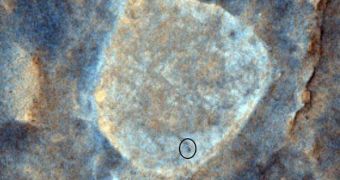Designed to operate for only 90 days, driving across the red surface for almost four years and experiencing multiple mechanical failures, Spirit now hits another problem. While heading towards a slop which was supposed to ensure the optimal angle for collecting sunlight, the rover got stuck in what NASA thinks might be, loose soil. Operators on Earth must now find solutions to free Spirit before the coming of winter, otherwise the mission may be stopped.
Spirit began the trip towards the northern end of a strange plateau, 90 meters wide, called Home Plate, which could present an angle that would maximize the amount of sunlight falling on its dirty solar panels, during the following winter season. Its operators hoped that the rover would reach its destination on 1 January, after which the rover could experience power failure in all critical systems. Spirit's solar panels have been covered with a thin layer of dust, as a result of dust storms which raged on the Mars surface only a few months before. But, while the twin rover, Opportunity, gets its solar panel frequently cleaned by wind gusts, Spirit is located in an area were the wind is not powerful enough to clean it.
However, after a few days from when the rover started its journey, it got stuck. The engineers from NASA, operating the vehicle, sent a new set of commands to Spirit, to get it on the move again, by turning it and then trying to drive in another direction, so that the hazardous region would be avoided. The rover can only drive backwards, since the middle of last year, when the right-front wheel had experienced a motor failure.
On Monday night, the rover freed itself from the loose soil, by moving half a meter from the position where it got stuck; however, due to insufficient power, it can only drive for 30 minutes at a time, and it still has to climb a 11 degree slop in loose soil, while dragging along a dead wheel.
During this time, the Mars Reconnaissance Orbiter, equipped with HiRISE, took several color pictures of the location where the Spirit rover was present. The High Resolution Imaging Science Experiment, or HiRISE, is the most advanced optical device, outside Earth's orbit, and is capable of taking detailed color images that allow surface observation. Though experiencing problems with the analog-digital converter of the camera's CCD's, it is still able to send back to Earth enormous amounts of information.
The camera on the orbiter, is using 14 CCD's, instead of just one, which operate at very high rates. In order to compensate for the errors, the orbiter's operators heat up the camera from its usual temperature of 18 degrees Celsius to 32 degrees, which makes it difficult to take multiple pictures in a small amount of time, because the high temperature might damage other electronics, and the camera must be left to cool down for up to half an hour after each picture.
To make it more effective, the operators chose to take one large picture every orbit, instead of taking multiple pictures, so that the camera would have enough time to cool down, during its time on the back side of the planet. Also, they are taking into consideration the fact that the camera might be permanently damaged by working at high temperatures, and are studying whether the half hour is indeed enough to cool down the camera, otherwise the time needed to take just one picture could rise dramatically.

 14 DAY TRIAL //
14 DAY TRIAL //